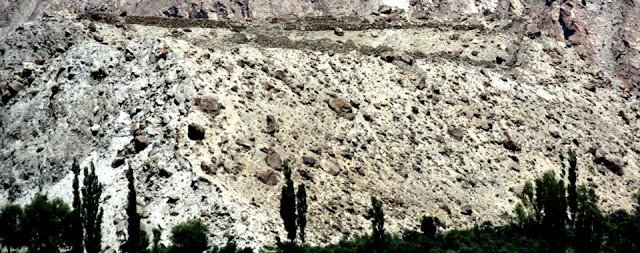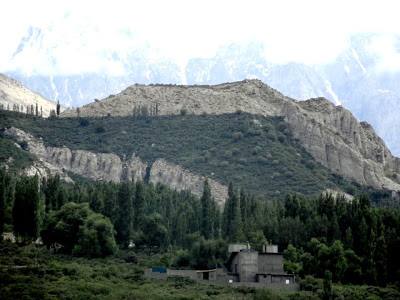Confined history of Ondra Fort (Ondra Qlaa) Gulmit Gojal
We have reached to the moon with the help of modern technologies but still we are looking for the remains of disappeared species, and human civilization still some of us are in search of their origin their history and territories, no matter how ignorant we are but we can’t forget and live without our history. During my studies I took the charge to dig some facts and figures regarding the history of Ondra Fort in specific and Gulmit in general, which was quite difficult but interesting at the same time. I am really thankful to my respondents who helped me to collect some facts and figures from the past.

Conferring with my respondents (many of them are old aged genealogist of Gulmit) I came to a conclusion that Ondra Fort has been built during the ruling era of Mir Qutlugh around 900 years ago Mir Qutlugh was the first Wakhi ruler of Gulmit and its surrounding areas.
Mir Qutlugh’s power throne reached to Khayber (a small village after Passu) and to strengthen his defense he constructed two gates (of mud, stones and woods). One was built at Khyber village (used to call Khayber-Durwoza) to protect his territory from Qirghiz (China) invaders and other at the Chamangul river side of Gulmit, to protect his main territory form the invaders of Hunza (Kanjut) and Nager (Nagriks) .
Unfortunately there is not enough evidence left to witness the past but some remains of these gates and the defense wall can still be seen at Khyber and Gulmit. As years passed and the possibilities of threats increased he decided to build a fort with the help of locals which is known as Ondra fort Gulmit.
There were living quarters inside the fort, still some of the remains are crying their evidence, The quarters in the north west side were constructed for the army of Qutlugh (the army were included the locals only) to keep an eye on enemy movements from that side and the southern quarters and house like were used by the soldiers to watch the enemies from Hunza side.

The defense wall has been provided with loopholes for monitoring of the area and also giving opportunity to the defenders to fire through. The battlements of the fort are still in evident condition but some part of the defense walls have crumbled. Ondra fort imitates the power of Wakhi ruler Qutlugh who was never defeated by the Mirs of Hunza nor any Qirghiz. He was famous for his chivalry and swordsman ship. The Mirs of Hunza were scared of his rising power. They never dared to cross the territory. Mir Qutlugh was poisoned to death by one of his elderly female servants, which was especially on this mission sent by Mir of Hunza. She managed to feed the poisoned food to Mir Qutlugh and his other family members. Mir Qutlugh died after being poisoned, Gulmit was seized and Ondra Fort fell in to the hand of Mir of Hunza. Qutlugh was buried in Gulmit along with his other family members. According to the key respondent the grave of Mir Qutlugh was located somewhere the newly built government girls high school.
Mir Qutlugh ruled over Gulmit and its adjoining areas for almost Twelve years. During his ruling era everything was safe and locals were happy but the invasion of Hunza Mirs totally destroyed the social setup of the area.

According to my key respondents, Ondra Fort was renovated once during the ruling period of Mir Saleem Khan and some were in a view that it was renovated during Mir Ghanzafar Ali Khan 1st ruling period. Although the difference is there but my respondents were agreed that this Fort was once renovated, and most probably during Mir Saleem Khan’s era because he was much focused on defense and protection of the area. Most the people (who participated in the renovation work) from Gulmit village and some of them where form the neighboring villages.
Mirs of Hunza were brutal and their approach was inhuman towards the locals of Gojal. Mirs of Hunza started huge tax (in good form, like wood, fruits, animals, and other valuable things) collection by force which was absolute merciless and unjust. Mirs of Hunza used Gulmit as headquarter during summer camp, especially to collect tax from the locals with the help of admirers of Mirs from Hunza and from Gojal (normally the people who were used in accompanied during Mirs visit were Tharampfa, Wazir, Arbob, Chorbu, Munshee, and other family members and servants).
During their ruling era Mirs of Hunza snatched numerous land pieces from the locals in various parts of Gojal and they forced the locals to work for them (the locals call it Mir Hashar). That’s why the sentiment of hatred and enmity surged in many parts of Gojal against Mirs and their admirers, which later ended with Prime Minister Zulfiqar Ali Bhutto’s dissolution order.
The locals left this Fort during the ruling period of Mir Muhammad Jamal Khan Completely, because of developed consensus and good relationship with the Mirs of Nager and Sirqolies, later on this Fort lost its importance among the locals which led to deterioration and demolition of this fort.
Authors get paid when people like you upvote their post.
If you enjoyed what you read here, create your account today and start earning FREE STEEM!
If you enjoyed what you read here, create your account today and start earning FREE STEEM!
Hi! I am a robot. I just upvoted you! I found similar content that readers might be interested in:
http://oinomancy.blogspot.com/2011/05/
Downvoting a post can decrease pending rewards and make it less visible. Common reasons:
Submit
yes thats my also my personal blog
Downvoting a post can decrease pending rewards and make it less visible. Common reasons:
Submit
Congratulations @deedaar! You have completed some achievement on Steemit and have been rewarded with new badge(s) :
Click on any badge to view your own Board of Honor on SteemitBoard.
For more information about SteemitBoard, click here
If you no longer want to receive notifications, reply to this comment with the word
STOPDownvoting a post can decrease pending rewards and make it less visible. Common reasons:
Submit